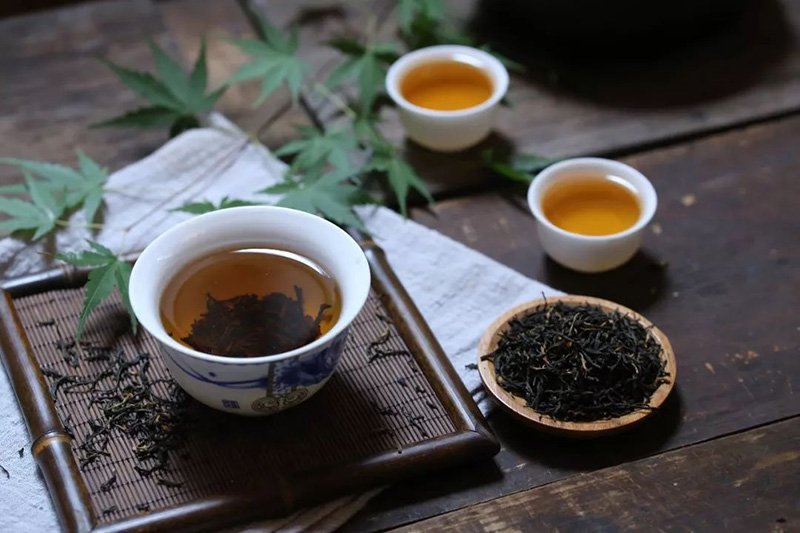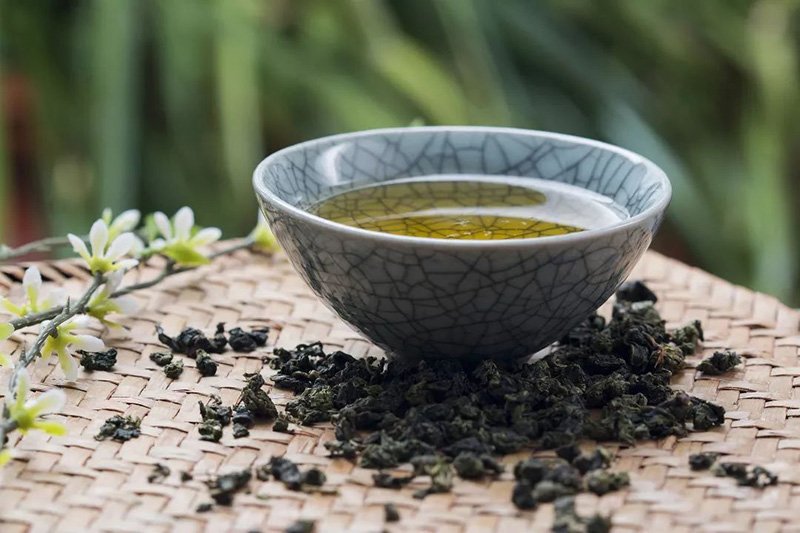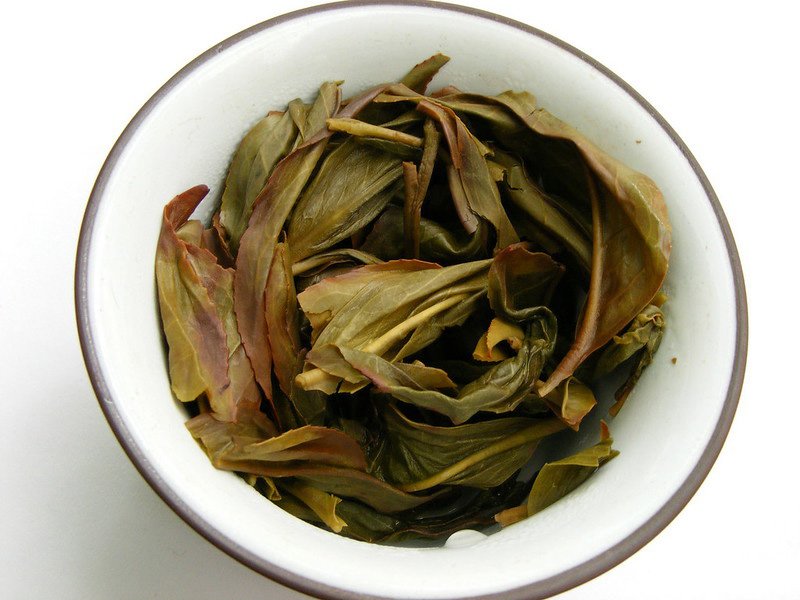Introduction
Many people may confuse the oolong tea and green tea because the tea leaves are dark green. That is a mistake. Oolong tea is different from green tea, and it belongs to partially-fermented tea. Oolong tea’ s fermentation degree is between black tea and green tea, also depending on different origins.
There are various stories about how this tea got the name “Oolong.” One said that because the tea shaped like a dark dragon. And the other said that “Oolong” is named by the tea master who invented it.
And one interesting story said that “Oolong” was invented due to a mistake. “Mistake” called “oolong” in Guangdong, the meaning just like “own-goal.” A tea master was lazy while drying the green tea, which caused the tea pile to turn dark and look like a dark dragon, quite shocked to the tea master. Colleagues mocked him “created an own goal” (oolong), so named the tea”oolong” he made.
Oolong tea tastes different from one origin to another, but the common feature is a strong aroma, and the lasting sweet taste left in the oral cavity after having.
Oolong tea also knows as “beauty tea.” It has excellent help with losing weight. This benefit is the other reason oolong tea popular in people except for its unique taste.
Oolong Tea Nutrition Fact
Polyphenol
Oolong tea does not contain as much tea polyphenol as green tea and other mildly-fermented teas, most of them are transformed into other nutrients during fermentation.
Catechins and tea pigments are the primary polyphenols in oolong tea.
Due to the different degrees of fermentation during processing from one origin to another, the tea polyphenol retains in oolong tea also different.
Tea polysaccharide
Tea polysaccharide is a compound nutrient fact in oolong tea, which formed in the fermentation process. Although black tea is fermented tea too, due to the high fermentation(black tea is completed-fermentation tea), the tea polysaccharide content in black tea is much lower than oolong tea.
In addition to sweetening oolong tea, tea polysaccharides are an excellent nutrient fact that helps lower blood lipids and blood sugar.
Amino Acids
During the fermentation of oolong tea, most of the amino acids in fresh tea leaves switched into other substances. A part of amino acid transformed into the aromatic material, which made oolong tea got a strong scent; another part is preserved, which can be soluble in water, and forms the flavor of oolong tea.
Caffeine
Oolong tea is a kind of true tea, and it contents caffeine. The caffeine it contents is lower than green tea, because of some of the caffeine is lost during fermentation and baking. Caffeine has the function of refreshing the brain, and helping digestion, is a common nutrient of tea drinks. But take too much caffeine may cause insomnia.
Minerals
Oolong tea is rich in minerals such as K, Ca, Mg, Fe, Mn, Cu, and F. These essential trace elements cannot be produced or synthesized by the human body itself. Moderate intake helps to maintain the human body’s function.
Oolong Tea Benefits
Hypolipidemic
Oolong tea is rich in catechins, a polyphenolic substance that has antioxidant and hypolipidemic effects.
The studies suggest that after the subjects consume oolong tea for a while, the level of blood lipids in the body decreased significantly, and the mild fatty liver returned to the normal liver state. And oolong tea is more effective at reducing triglycerides than green or black tea.
Manage Diabetes
The tea polysaccharide in oolong tea has the effect of stimulating insulin secretion. The study suggested that the concentration of glucose and fructosamine in diabetic patients’ bodies decreased significantly after having oolong tea. Combined with oolong tea can balance plasma glucose more effectively than drugs taken alone.
Besides, type 2 diabetes is mostly associated with obesity. Oolong tea can help with weight loss, effectively manage type 2 diabetes, and reduce the risk of suffering diabetes.
Weight Loss
Help weight loss is the effect that oolong tea gets concerned most. Lots of studies have confirmed that oolong tea has a significant impact on decomposing fat. It mainly ascribes to the synergistic effect of tea polysaccharide, tea polyphenols, and caffeine in oolong tea.
Tea polyphenols and tea polysaccharides can effectively inhibit the accumulation of fat inside the body and accelerate the combustion of fat to provide energy to the human body.
At the same time, oolong tea can also help promote the metabolism, reduce the accumulation of metabolites in the body, also play a positive role in losing weight.
Worth to know, in the comparative study, the researcher found that compare not fermented green tea, the effect on losing weight that fermented oolong tea is better.
Anti-Cancer
The tea polyphenols in oolong tea are a natural antioxidant. It can induce cell apoptosis, inhibit cell proliferation, and the form of tumor vessels. It also has an anti-inflammatory feature, reducing inflammation in the body and the risk of cancer.
Researchers have experimented with oolong tea extracts, which has shown great potential in preventing breast cancer.
Dermatitis Treatment
Oolong tea deemed to have a therapeutic effect on dermatitis. In one study, 118 patients with Recalcitrant Atopic Dermatitis (AD) tested, and 74 (63%) of them improved significantly after having oolong tea for 1 month.
The researchers speculate that the antiallergic properties of the polyphenols in oolong tea took a powerful effect on the treatment.
Although there is not enough evidence to support oolong tea as a treatment for Recalcitrant Atopic Dermatitis, it generally helps in mild cases.
Oolong Tea Origin
China is the birthplace of oolong tea, also the largest producing country in the world. In China, the primary origin of oolong tea is Guangdong, Fujian, Taiwan, and other provinces. Due to the long distance between each origin, oolong tea from different sources also has significant differences in flavor.
Guangdong
The production of oolong tea mainly concentrated in the Chaoshan area of Guangdong, and the well-known one is Phoenix Dan Cong tea.
Oolong tea from Guangdong is famous for its rich scent, which can divide into several grades according to the intensity of aroma.
Phoenix Dan Cong’s tea leaves are more completed, can still retain a particular fragrance and taste after brewing many times.
Southern Fujian
The famous Tie Guan Yin is from Anxi city in Southern Fujian province. Tie Guan Yin tea is golden in color, light in taste, and with little sweet. The strong orchid scent is the most attractive point of it, and the smell can refreshing your mind.
Northern Fujian
The Wuyi mountain area in northern Fujian produces many famous oolong teas. Such as Wuyi rock tea, Da Hong Pao, Tie Luo Han, Wuyi narcissus, and so on.
The superior geographical environment makes the oolong tea produced here rich in taste and fragrance. And high-quality Wuyi oolong tea production is low, so the price is getting relatively high.
Taiwan
The representative of Taiwan oolong tea is the Dongding oolong and Oriental beauty. Dongding oolong has a low degree of fermentation, about 25%, so it retains most of the fresh tea fragrance. And the fermentation degree of Oriental beauty is higher, about 70%, the taste is relatively close to the black tea of completed-fermentation.
Other Origin
In addition to China, such as Japan, South Korea, India, and Malaysia also produce oolong tea, but not nearly as much as China.
Oolong Tea Producing
Withering, lay leaf (make green), stir fixation, rolling, and drying are the main processes in oolong tea production. The lay leaf process is unique to oolong tea, which distinguishes oolong tea from other types of tea.
And what is lay leaf? After withering, put the tea leaves into the rolling machine for rolling, let the tea leaves crash each other, destroy the edges, and the edge part of the tea leaves will ferment faster.
After lay leaf, the tea leaves will get harder. Place them for a while, the fermenting speed slows down, and the water from the vein will diffuse to the whole leaf, tea leaves turn soft again.
After all these steps, a series of chemical changes happen inside the tea leaves. Because of the fermentation degree is different, the tea leaves have red edges and dark green center, so-called “green leaf and red edge.” The aroma and taste of oolong tea are also basically formed.




No comments:
Post a Comment